So, you are ready to list your products on Amazon. But, hey! Did you do the homework? The research that can make your Amazon listings more visible to the target audiences and increase your sales.
Is it pending? Yes?
You need to postpone product launching right now! Get attentive and start making notes as the following article can dramatically change your life.
What are we discussing, anyway? It’s about Amazon SEO. The powerful yet overlooked aspect to skyrocket your sales on the giant marketplace. Amazon SEO can distinguish your products from a pool of similar offerings from different vendors, and promote the buyers to shop from your business.
Sounds interesting? We can make it happen! All you need is to understand the concepts of Amazon SEO, leverage them correctly, and generate substantial sales. That’s it!
Below we will discuss everything that you should know about Amazon SEO. Auxano Global Services brings the Ultimate Amazon SEO guide for your business.
But, halt!
Before diving into hardcore technicalities and advanced concepts about Amazon SEO, it’s time to blow your mind with some numbers.
- Amazon is responsible for over 40% of online sales.
- More than 50% of shoppers turn to Amazon for online shopping.
- Amazon SEO can increase your sales by 320% within 10 minutes!
Impressive, right? Now that you are all buckled up to learn Amazon SEO and leverage the hacks, let’s begin the discussion.
Keep reading!
Say Hello to Amazon SEO!

Till now, we have already referred to Amazon SEO quite a few times. But what on earth is Amazon SEO? Let’s try to understand!
Essentially, Amazon SEO is a bunch of optimization techniques to refine your presence on the marketplace, enhance your brand visibility, drive more prospects, and ultimately generate higher sales.
What exactly does it do?
Well, Amazon SEO ranks you according to some parameters and shows your product listings to the top before a massive Amazon user base. Consequently, your sales transition from good to better than expected in almost no time.
So, what are the parameters that Amazon chooses to rank your listings?
Products on Amazon aren’t listed randomly. The marketplace algorithm evaluates each listing according to the following parameters and decides their rank on search result pages.
- Top Keywords
- Query Relevance
- Probability of Getting Purchased
A Glimpse of the Amazon Algorithms

We recently discussed the parameters that Amazon uses to gauge your seller account and the products’ sellability.
Once you impress the Amazon algorithm on those parameters, it takes you high on the results page.
Did we say Amazon algorithms? Yes, we did!
So, what are they? And how do they work? Here is everything that you should know about the famous Amazon algorithms. Stay tuned!
The Amazon A9 Algorithm
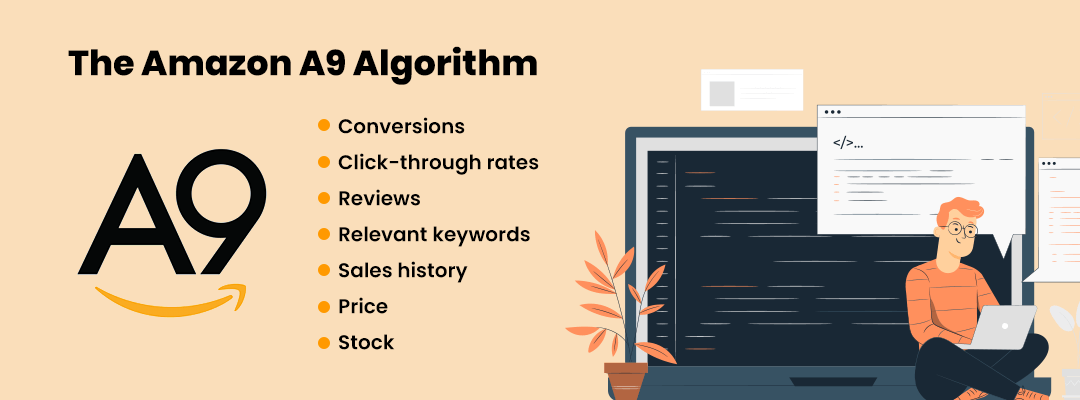
Amazon registers thousands of product listings every day. How does it segregate them and shortlist the top-ranking ones?
The answer is simple. Algorithms!
The Amazon A9 algorithm is the underlying architecture that ranks all sellers and their products and decides whether the listings should appear at the top or not.
Many people consider Google’s and Amazon’s algorithms to be similar. However, a noteworthy fact is that Amazon is a hardcore eCommerce business. Unlike Google, Amazon does not restrict only to returning high-quality answers to user queries. It extends much beyond!
Amazon views the listings from a business perspective and prefers the ones having a higher probability to convert. So, you can expect the businesses that have a better conversion record to show up on the results page.
It has two inferences: One, you can expect better sales on Amazon if your account has had a demonstrated history of mind-boggling conversion rates. Second, as their sales get better, these accounts become highly ranked by the Amazon A9 algorithm.
Again, the Amazon A9 Algorithm considers a few factors to assess the listings on the marketplace. Although the eCommerce giant did not reveal the algorithm factors directly, we can still derive a few inferences. Take a look at the below parameters that A9 follows:
- Conversions
- Click-through rates
- Reviews
- Relevant keywords
- Sales history
- Price
- Stock
Apart from the above topmost factors, A9 indirectly considers the following parameters.
- A+ content
- Images
- Advertising
- Promotions
- Fulfillment Method
What’s Inside the Amazon A10 Algorithm?

Yes, you’ve guessed it correctly! A10 is an updated version of the Amazon A9 algorithm.
What’s new with the A10 algorithm?
Well, A10 is more customer-oriented than its predecessor. They enhanced the A9 algorithm to put consumer experience on Amazon in the first place.
As we already discussed, Amazon viewed products from a business perspective through the A9 algorithm lens. However, the arrival of A10 reduced the priority for business profitability and promoted customer experience with the marketplace.
A10 focuses on displaying accurate results to the customers on the Amazon storefront. Unlike the oldie A9 algorithm, the latest update prioritizes user-friendliness regardless of the profits that the company generates. So, it altered the weightage of product ranking factors on Amazon.
As you saw the A9 algorithm involved advertising and promotions among the topmost factors for product ranking. In contrast, PPC lost its reputation with the arrival of the A10 algorithm. Promoted products aren’t always the answer to searches, after all.
Are you wondering what made Amazon shift its focus from profits to CX? It’s because the eCommerce giant wants to regain its supremacy in the industry. The profit-minded algorithm created a misleading impression among users with promoted and ‘useless’ products being shown at the top.
Whatever may be the underlying reasons, the change has been implemented in Amazon. The A10 algorithm is functioning and producing sweeter outcomes for the consumers.
Now, let’s walk through the noteworthy factors influencing the A10 algorithm.
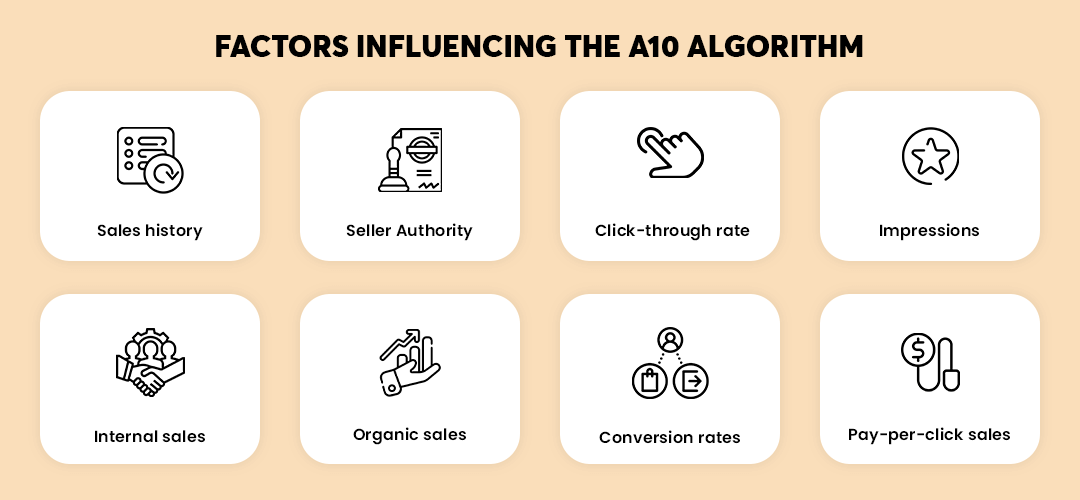
Are you worried about why we discussed the Amazon algorithms? Because they are the ultimate targets for vendors on Amazon.
Understanding the target and getting familiar with all its aspects is essential for hitting it precisely. In other words, you need to know the Amazon algorithms to orchestrate an unbeatable SEO strategy for your listings.
Amazon SEO – How Does it Work?
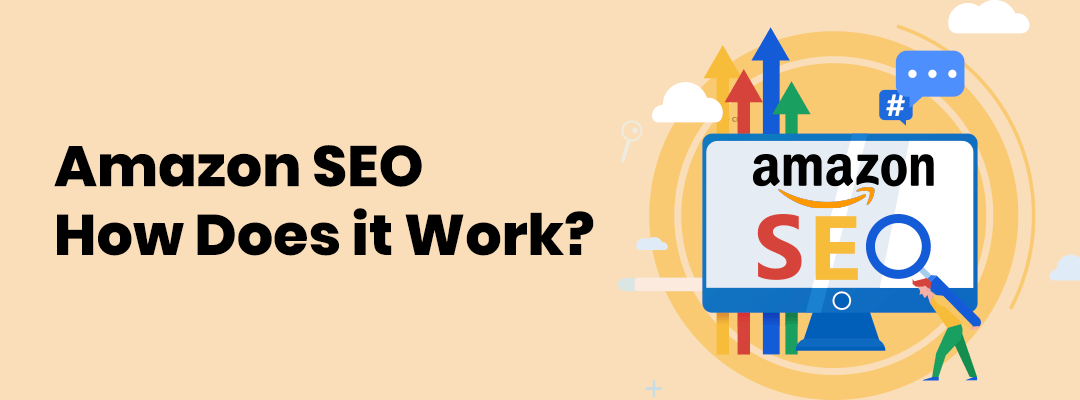
Everything might seem scattered and haphazard to you till now.
You need to put the algorithms and factors in the right places to get things working. And that’s how Amazon SEO works!
Now that you have a knee-deep understanding of the A9 and A10 algorithms, it’s high time to discuss the working of Amazon Search Engine Optimization.
First things first! Let’s keep the algorithms aside for a while. Considering the algorithms beneath each optimization principle can overwhelm and ultimately intimidate you. So, keep it simple and forget the A9 and A10 algos.
All you need to understand is that Amazon SEO depends on some factors. You can break down the parameters into three broad categories:
- Product Listing Optimization
- Performance Optimization
- Anecdotal Optimization
Don’t get confused by the above names.
We’ll take one optimization strategy at a time, and dive deeper into each of them. Follow along with the article.
5 Killer Product Listing Optimization Strategies for Amazon
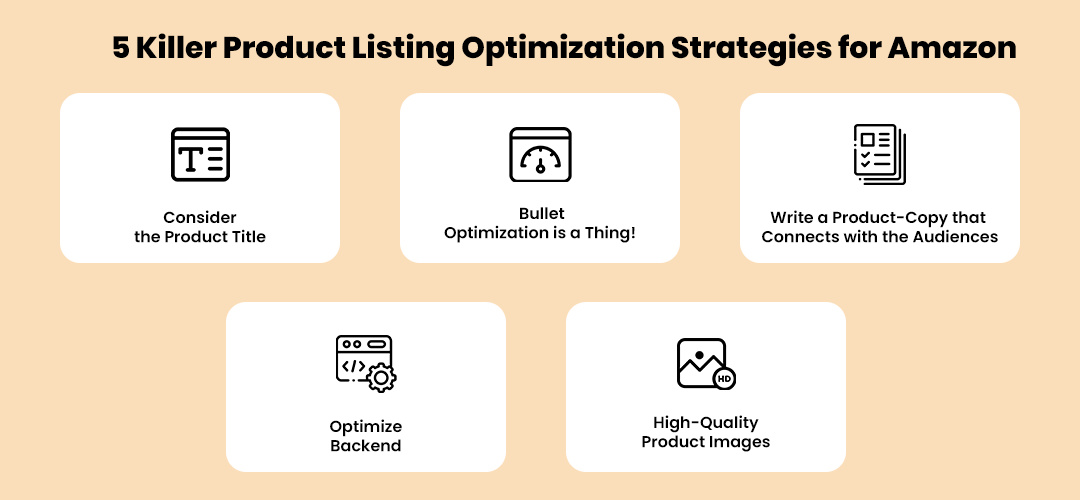
The more value-added to a product, the better is its Amazon ranking.
That’s a universal law. It means that your products should showcase some value for the consumers for Amazon to promote them before the buyers.
Many times, your products fail to converse their value to Amazon. Consequently, they do not get a higher rank, regardless of their worth for the consumers.
What’s missing? How to let Amazon understand the value of your products? Or, more precisely, how to get a higher listing rank on Amazon Search Engine Results Page?
The answer to all these questions lies in Product Listing Optimization!
It means updating your product pages and embedding the Amazon algorithm’s favorite entities to get a better search ranking on the marketplace. So, you can drive better product visibility and massive sales from the eCommerce platform.
Enough of what-is. Let’s now dig into the how-to part! Here’s how you can optimize your product listings on Amazon.
1. Consider the Product Title
Suppose, you opened Amazon and searched for a product.
The algorithm emerged with tons of results based on your query. How would you choose to open one of them? Will you consider the product image or read the title?
Yes, you would read the product title before clicking through it.
So, product titles have more significance than anything else on the Amazon marketplace. It has a straightforward effect on your prospects’ buying decisions. Among all other product listing optimization techniques, the title remains a thing among sellers and SEO experts.
Does Amazon say anything about product titles? Yes, they do!
Here are some of the game-changing entities your product titles should contain, as prescribed by the eCommerce giant. Have a look!
- Product Line
- Material
- Key Features
- Product Type
- Size
- Color
- Quantity
- Packaging
- Brand
- Target Keywords
Weaving these entities into an effective product title depends on you. Here are some tips to craft a successful listing title.
1. Title Length
If you are familiar with meta tag optimization for Google, you will agree to the fact that the search engine pays close attention to the length of the page title.
Amazon has a somewhat similar ideology. You need to embed sufficient characters in your product titles to optimize them for better visibility.
Ideally, titles for the organic search results have 115-144 characters depending on the product category.
In contrast, Amazon expects the mobile titles to have around 55-63 characters.
When it comes to right rail ads, the titles should have a length of 30-33 characters.
2. Most Relevant Keywords First
Once you know the correct length for a product title, it’s time to decide what’s to be included.
Begin by searching some keywords for your products. Pen down some of the top-performing phrases in your niche. And that’s it! You’ve figured out a fraction of the title already.
Leveraging targeted keywords at the beginning of a product title serves two purposes: Firstly, you can directly communicate with the buyers stating what the product is all about.
Secondly, such an attempt reveals Amazon’s algorithm about your listings and helps it display the products to the customers at the best time.
3. Mentioning Brand Name
Whether or not to include the brand name in your product listing titles – that’s a starting line for debate. Various Amazon sellers and SEO experts have different views on the topic.
There’s a straightforward formula to deduce if including the brand name in product titles will be profitable.
Are you an established business? An industry leader? Or a newbie?
Ask these questions to yourself to get an answer.
Mentioning the name of your brand in the Amazon product title can be highly profitable if you are a leading enterprise in the industry. Your customers can recognize you on Amazon, providing you with more engagements.
However, incorporating a brand name in the listing title might not benefit you much when you are a newbie and few customers know your services. Although, such an attempt might make the titles appear more professional, leading to some conversions.
4. Don’t Stuff Keywords
Did you ever come across listings comprising jargon without much sense? They sound terrible, don’t they?
You need to escape such a habit. To be honest, consumers and Amazon users notice your titles and decide whether to click through the link or not.
Stuffing the titles with jargon hides valuable information about the product from the consumers, especially when they access Amazon using a smartphone.
Crafting the title with minimum keywords is essential to drive traction and appear at the top of Amazon Search Engine Result Pages.
5. Competitor Analysis is a Must!
Did you know? The high-performing competitors in your industry leave a thousand hints on how to slay Amazon SEO.
Analyzing your competitors and evaluating their efforts can be an excellent business strategy, especially when you are a beginner in the domain.
You can drive numerous inferences regarding what works in your industry, your audiences’ likes and dislikes, and so on.
For instance, you can refer to the top 3 competitor listings to find a legible way to craft a masterpiece title with all the necessary information. Also, you can learn how they use special characters like ‘|’, ‘&’, ‘,’, and ‘-’ to create short pauses in product titles.
What can you learn from a competitor? Probably, everything!
You can curate a comprehensive dataset of what’s useful and what isn’t in the industry from competitor analysis.
Do you know what’s more interesting? You can refer to the above datasheet at any point in time to solve all your title dilemmas.
6. Stay Up-to-Date
There’s no running away from the fact that buyers’ expectations and Amazon algorithms vary.
Analyze your competitors for some time and you will realize that they modify their product titles from time to time. For even the bestsellers!
So, keep an eye on what’s trending in Amazon product titles, and optimize your listings accordingly.
2. Bullet Optimization is a Thing!
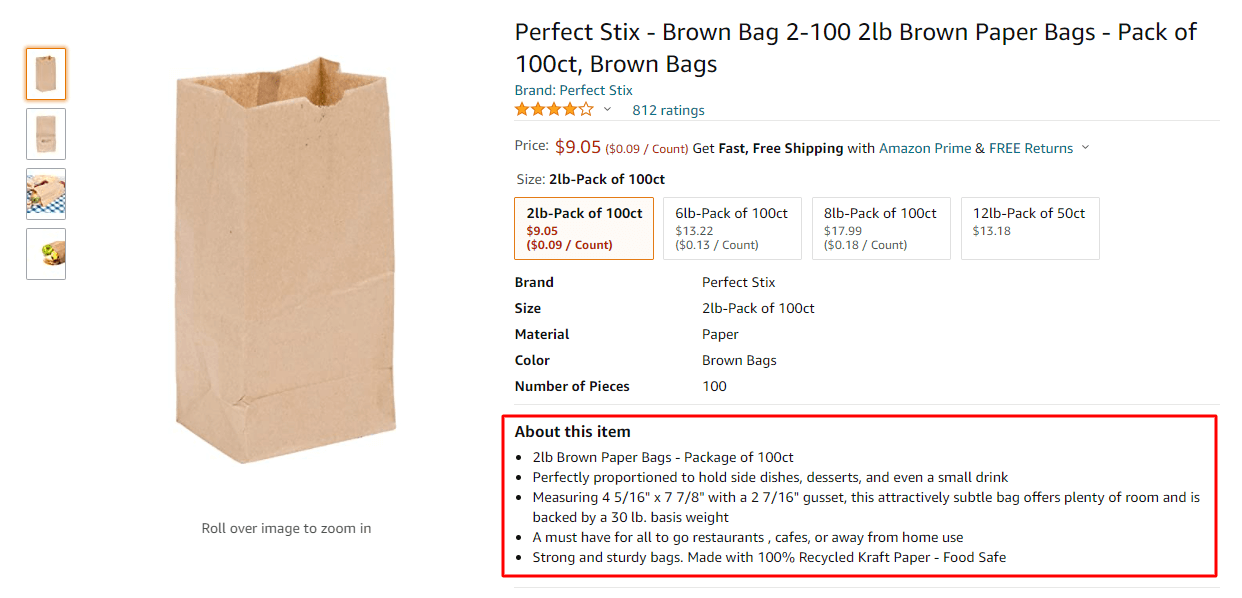
Here’s another chance to hit the ranking, relevance, and conversions mark: Bullets!
Although it might not bring you success overnight, bulleted product listings perform better regarding Amazon SEO. Besides, Amazon indexes bullets to rank your products on their result pages. You can invest your efforts in the bullet strategy to excel at two aspects – product relevance and conversion rate.
That’s what you are ultimately aiming for, after all!
Do you like to read long paragraphs? Or, try scanning keywords in a paragraph?
The latter, of course!
Believe it or not, your consumers access Amazon, reach out to your products, and go through its description in a few seconds.
Bam! Those few seconds are your showtime.
You need to make the best use of the crisp time and compel your potential buyers to convert. So, mentioning the features and benefits in a bulleted fashion can optimize the descriptions accordingly.
However, you should remember that features and benefits are altogether different. Intermingling them can be a disaster!
Also, arrange the features and advantages in decreasing order of priority. Such an arrangement will allow the rushing visitors to get a gist of all the classy features in your product, encouraging them to place orders immediately.
3. Write a Product-Copy that Connects with the Audiences
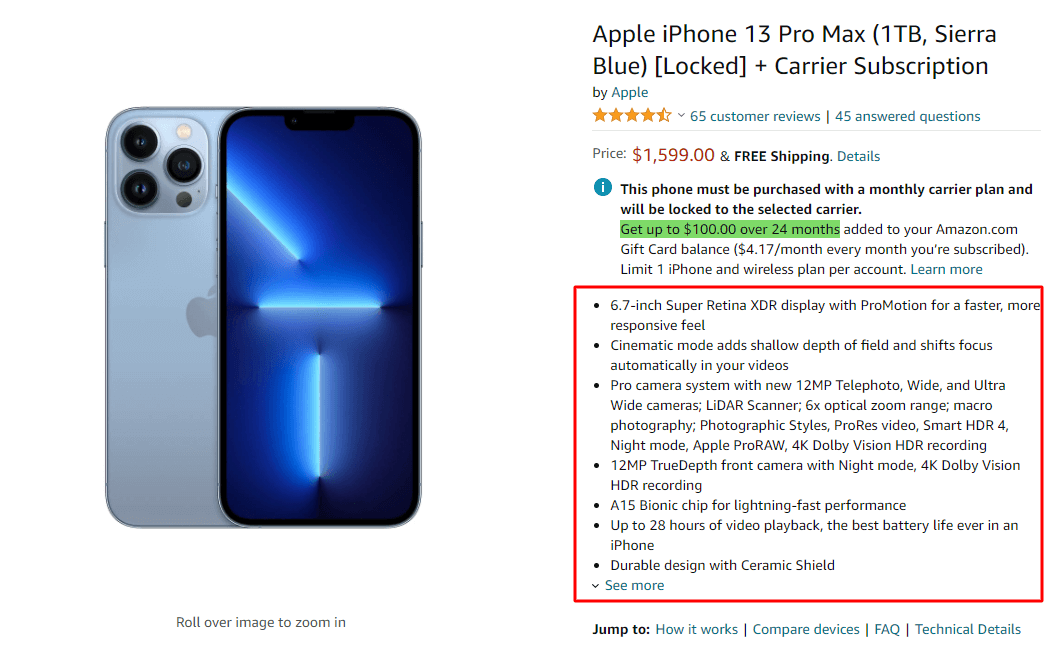
Have you ever read the product descriptions of leading brands like OnePlus and Apple?
Classy, polished, and reflecting a story – that’s what describes such product copies.
To achieve success in Amazon SEO efforts, you need to focus on the last part. That is, you require getting good hands to craft a product copy that connects with your audiences.
Another reason to invest your time writing product descriptions is that the Amazon algorithm indexes them.
But, how to write an interactive product description? We’ve got your back! Here are some tips to create a killing product copy!
- Use simple language that doesn’t take much processing time for the audience.
- Declutter extra words and keep the description concise and to the point.
- You already know the power of a bulleted copy. It’s your turn to leverage bullets and write a compelling product description.
- Focus on highlighting the benefits and not product features to connect with your buyers.
- Dig out some high-performing keywords and throw them into your product description.
- Leverage Call-to-Actions (CTAs) in the description to direct the potential buyers to take action and purchase your product.
- Finally, use direct language like Buy Now, Shop Now, etc. to strike an immediate action from the prospects.
4. Optimize Backend
Till now, we have been discussing the top keywords in your niche.
What about the remaining ones? Should you throw them in the trash? Hell no!
There’s a place to dump them and let Amazon index your products.
It’s located in the backend.
Backend optimization is a less-talked-about yet crucial aspect in Amazon SEO. Most experts and companies speak about the backend along with other aspects and get over the topic in a few moments.
Since Auxano Global Services is the leading Amazon SEO agency, we understand the necessity to optimize the backend of your product page.
Let’s understand the scenario with an example!
Say, you sell planters and optimize a flowering pot listing. How to optimize the backend in such a case? It’s simple!
You had a list of high-performing keywords in the beginning. Remember? Some of the keywords are a part of your product title and description and remain visible to the probable customers.
Get the other keywords handy and resort to the page backend. Here, you can dump all keywords and get extra attention from Amazon.
When users search for your flowering pots, they might use phrases like “flowering planters for daisies” or “flowering pots for tulips”.
So, you can leverage all the extra keywords here and mention the names of 100 local flowers to grab some more traction towards your product.
5. High-Quality Product Images

Enhance Click-Through Rates & Conversions
Product images have a significant impact on buyers’ decisions.
They can bring better-than-expected click-through rates (CTRs) and conversions for your products.
Do you know what a low-quality image means? It generally implies that the prospects will not look at the product title, description, etc. after disliking the main photograph.
Even worse is that the targeted audience will bounce off to competitor listings, yielding them more conversions.
So, all your indexing efforts go to trash if the main image isn’t compelling enough.
You need to pay more attention to using optimized product images having the following attribute.
- The chosen image should have one of the following extensions: JPEG, PNG, GIFF, TIFF.
- The image resolution should lie in the range of 1000-5000 pixels.
- It should not burst out upon zooming.
- Utilize the 360-degree viewing options for the customers to engage with your products and spend more time on your page. It might lead to more sales eventually.
- Images with a blank background perform better than the ones with a colored background and some props.
- Ensure that the product in focus fills almost 85% to 100% of the available region in the image.
- Images with external texts, CTAs, and details are disasters. Avoid using them.
- Apart from the main image, use high-quality product images as additional photographs.
Fine-Tuning the Performance Game
You are all done with the product listings and ‘hard’ optimization.
Now, it’s time to partly savor the fruit and input some more efforts into the Amazon SEO strategy.
Do you know that some SEO aspects are highly undermined? Yes, that’s true! Experts do not talk about these underrated steps, generally.
What’s the impact? The competitors grow more and more on Amazon.
What do you get? Mere disappointment, unfortunately.
Once your product listings are optimized, there’s no rest. You need to remain attentive and watch out for some more performance metrics.
You’ve guessed it right! We are discussing performance optimization techniques for Amazon listings.
What is it? How do you excel at it? And answers to some more similar questions are right below.
Buckle up and get ready for another exciting ride in our journey to win-over Amazon SEO!
1. Sales, Conversions, Ranking, and Relevance are All Related.
Did you ever observe that established businesses get better exposure and conversions, in turn?
Yes, the Amazon algorithm is kind of ‘biased’ towards well-performing businesses. Do you know why?
It’s because a business with a phenomenal sales record means it’s preferred by the customers. Okay, next?
Now, customers tend to like high-quality products and recommend them to others. What does that infer?
It transitively means that an established business on Amazon sells premium products. And that’s what the A10 algorithm seeks!
Amazon released the A10 algorithm to serve value to the customers on the platform. Remember?
So, it displays the products from those businesses to the customers.
What are the takeaways here? Have a look!
- As you become a pro-player in the Amazon marketplace, its algorithm starts noticing you more.
- Over time, your products get better indices and show up before the audiences (at least in the 4th or 5th pages).
- Gradually, customers notice your valuable products and interact with the listing, generating more sales.
- As your sales increase, so do the relevance and ranks!
- Your products get the highest boost when it enters the first or second pages.
Is it all over now? Nope! You require to maintain the rank and make efforts to overtake the competitor listing. Here’s how you can do so!
1. Generating Internal Traffic
As the name suggests, you get internal traffic from Amazon itself. How so? Through Pay-Per-Click (PPC) advertising!
2. Harnessing External Traffic
While you are still new to the eCommerce platform, you might require more effort to become visible to the buyers. That’s when external traffic comes in through Facebook, Google, Instagram, and Pinterest ads.
2. The Supremacy of Customer Reviews!
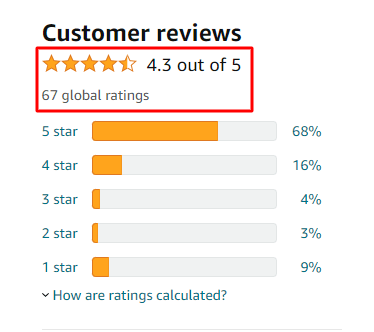
Human instincts lie in favor of businesses suggested by friends and families.
A similar trend is observable on online marketplaces like Amazon.
Here, buyers tend to rely on existing product reviews. Listings with numerous positive reviews attract more conversions. In contrast, the ones with no or negative reviews backfire.
Statistics and studies reveal that even a slight increase in the number of product reviews increases its rank dramatically.
All in all, you need to maintain positive product reviews and remain aware of what’s happening with the user rating. The Amazon algorithm supports such products and rapidly enhances their visibility.
Are you wondering how to maintain positive customer reviews for a product listing? Here’s what you can do!
- Encourage users to leave an honest review on the product page after receiving Amazon delivery.
- Keep an eye on the negative reviews and make necessary changes to your services to attract better user reviews.
- Amazon hates biased, fake, and paid reviews. So, refrain from filling your product pages from such efforts, and keep damages to your reputation at bay!
Anecdotal Optimizations: Techniques that Won’t Harm!
Have you tried all the above techniques? Are your competitors still performing better on Amazon?
Something’s fishy!
The competitors might be leveraging some more optimization efforts for their products.
Although not discussed frequently, these optimization strategies can lead your brand through inches on the marketplace.
So, without further ado, let’s walk through these techniques below!
1. Fulfillment by Amazon (FBA) Might Give an Edge!
While Amazon has never uttered a word about the relation between FBA and product ranking, they still seem to be dependent.
Amazon trusts its fulfillment service.
So, the products that Amazon fulfills seem to be more reliable for the company.
Hence, you can see a hike in the rank of listings that Amazon fulfills over products that the marketplace doesn’t.
Sounds strange, but it is the truth!
2. Leverage Seller Name in Product Listings
Like brand names, incorporating seller names in product listings leave a positive impression on the Amazon algorithm.
Adding a seller name to your listings becomes more necessary if it contains keywords that rank well in your niche.
3. Don’t Leave Any Product Field Empty.
Amazon has strategically crafted all the fields in the ‘Edit Product’ panel.
It comprises information that helps the A10 algo in getting a better picture of your listing. Also, these attributes provide a bunch of other insights like targeted geography, audiences, and product category to the Amazon algorithm.
So, leaving any field empty can be dangerous for your SEO efforts.
The situation becomes serious when your competitors spend immense time filling out the fields and getting an edge on the marketplace.
That doesn’t mean stuffing them with false or irrelevant information.
Remember that Amazon indexes all these attributes and adds them in ranking your product listing. So, study all the fields and strategically fill each of them before releasing a product on the marketplace.
How Can Auxano Global Services Help You?

Hopefully, Amazon SEO has become a cakewalk for you.
That’s about the theoretical aspect. What about the implementation part?
Sounds tricky, right?
Don’t worry; we’ve got your back!
The masters of Amazon SEO are here!
Auxano Global Services is the best Amazon SEO agency and offers classic optimization solutions to customers.
Are you wondering what makes us lead the industry? Here are some of the attributes that provide us with an edge in the market. Have a look!
- We are available in the industry for eternity. That is, we have extensive experience in Amazon SEO.
- Our team is well-acquainted with the Amazon algorithms. So, we can suggest the best for your products.
- We have worked with numerous brands and sellers on Amazon. So, our suggestions and strategies are experience-driven and highly successful.
- Our Amazon SEO professionals remain available to tweak your product listings from time to time to maintain consistent results from the marketplace.
- Team AGS works to polish on-site and off-site SEO attempts to push the maximum traffic towards your products and seller account on Amazon.
Amazon SEO is an ocean of opportunities. It has numerous checkpoints, things to consider, and possibilities that you should watch over being a seller on the marketplace.
Does that sound overwhelming? We can help you if that’s the case! Get in touch with us and skyrocket your Amazon revenues today!
People also like to read:-
Frequently Asked Questions
-
1. What is Amazon SEO?
Amazon SEO refers to the implementation of a bunch of techniques to enhance the visibility of a product listing, get higher ranks on the Amazon Search Engine Result Pages (ASERP), and generate more conversions.
-
2. Why is Amazon SEO so essential?
Amazon is a massive marketplace with millions of sellers, listings, and monthly users. An Amazon business needs to harness the SEO techniques to edge their products, get more visibility, achieve enhanced ranks on the ASERP, and ultimately generate more sales.
-
3. What are the top Amazon SEO techniques?
Product listing and performance optimization techniques are the top-notch Amazon SEO hacks that a business should leverage.
-
4. Why invest in Amazon SEO?
The game of Amazon marketplace isn’t easy. Thousands of competitors strive to get into the first ASERP and drive massive traffic towards their listings. So, you might struggle to get the desired outcome on the platform. In contrast, Amazon SEO assists in skyrocketing your conversion rates in almost no time and provides the highest ROI.
-
5. Which is the best Amazon SEO company?
Auxano Global Services is the best Amazon SEO company. We have proficient SEO experts who have brought immense value to the eCommerce sellers over the years. Besides, we have an extensive understanding of the Amazon algorithm and craft compelling strategies for your listing and business. Contact us now.




![Latest Step-by-Step Guide To Magento SEO [2022]](https://cdn.auxanoglobalservices.com/wp-content/uploads/2021/12/Latest-Step-by-Step-Guide-To-Magento-SEO-2022.jpg)


